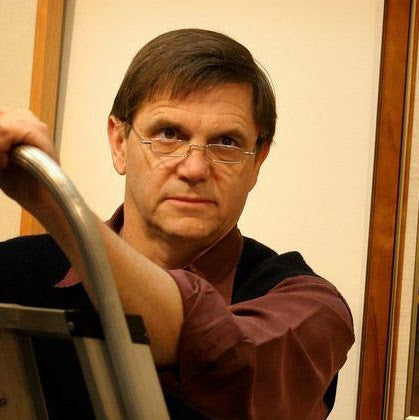Glassborow’s technically accomplished body of work delights in the contrast between the weight of his materials and themes of lightness and fluidity. The solid, enduring quality of the bronze is used to counterpoint the apparent weightlessness of the human figure. Glassborow, who has worked alongside the Australian Ballet, using many of its top dancers as his models, clearly communicates the sense that gravity- like other physical laws- is not inviolable. Like a skilled magician, his work celebrates the magic trick of the imagination.
Yet like a magician compelled to reveal his tricks, Glassborow often deconstructs the process of creation. The figures are sometimes revealed in their unformed or half-formed states. For example, ‘Point’ moves from an aesthetic that recalls the raw clay of the early modelling process, through a roughly finished and patinated green bronze, to the lush gold of the polished metal. The figure incorporates both naturalistic and mechanistic elements, creating a poetic juxtaposition between the material of antiquity and the imagery of the age of automaton.
Perhaps more than any other media, bronze carries with it the heavy weight of art history. Writing on his tendency to adapt the human figure so that it resembles a machine, robot or cyborg, Glassborow comments that doing so allows him to escape some of the conventions associated with this material. “It releases my thoughts. No longer is it a classical figure, no longer do I have to abide by the traditional proportions used in classical sculpture”. In many works, such as ‘Flora and Fauna’, the human form is caught between nature and machine.
This transition point is made explicit in ‘Double Exposure’, where the female form is vertically divided between a naturalistic form and one that speaks the language of computer generated imagery or robotics. The cubes protruding from the woman’s skin may indicate pixels, as if she is stepping out of a two-dimensional digital photograph and into a three-dimensional reality. Alternatively, they may be read as the control points or the exoskeleton of a highly evolved machine. While solid in construction, the piece has a lightness, as if this figure has been caught moving between states. This highly controlled juxtaposition of opposites extends from the imagery itself down to the way the bronze is finished. For example, many of the works contrast areas of rough material with areas of rich colour or high gloss.
One of the endearing features of the work is the poetic logic and wordplay of Glassborow’s titles, and they seem to provide a clue to his creative thinking process. British writer Marina Warner has observed the conceptual leaps made by the dreaming mind. She writes:
“This mental slippage, turning the figurative into the literal, is typical of the dreaming mind, which happily- and often amusingly- makes puns, especially on homonyms and proper names” (Stranger Magic 147). In ‘Hi Fashion’ an elegant figure is born aloft born by geometric wings, while ‘On the Nose’ features a horse head balanced precariously on its muzzle, bringing to mind the excited cry of a race announcer: by a nose. ‘Mumbo Jumbo’ is an elephant balancing on its trunk. This play of language, the magical language of dreams, emphasizes the otherworldly quality of Glassborow’s imagery.
Helen Hopcroft
Artist, Writer and Marie Antoinette Impersonator
‘Precious Metal’, an exhibition by Steve Glassborow opens at Cooks Hill Galleries 6-8pm Friday 22 September, 2017. More information, RSVP and invite your friends here.



Leave a comment